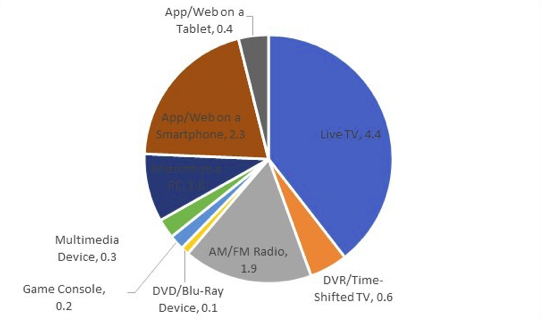The author of the material argues that it is too early to write off advertising on television. Along with the development of American TV, television advertising has also evolved since the late 1930s. This way of promoting products and services adapts to changes in the media environment, and so advertisers are still in demand.
You, probably, have already heard conversations about the fact that people no longer watch television.
And those of you who spend half an hour in front of the TV before going to work or a few hours at evening shows, sports or historical programs on weekends, probably think now that they have fallen out of life, or they have become too old and it is time for them to change their habits.
Or maybe the whole thing is not about you, but about these crazy, wireless, children who prefer smartphones and tied to social networks from 18 to 24, who have long said “goodbye” to TV?
The latter assumption is not as insane as it may seem: the updated results of
regular research from Nielsen show that television viewing rates in this demographic group have fallen by more than 40% since 2010, and among the adult half of millennials between 25 and 34 years old there is interest to this kind of entertainment fell by 11%.
But why then, you ask, so many online stores like
The RealReal ,
Rent The Runway or new marketplaces like
OfferUp , profitable aggregators like
Groupon or alternative lending platforms like
SoFi or
LendingTree , still continue to buy solid ad units CNN and CNBC to promote their brands?
And why do card networks and banks continue to hire actors and speakers to help them fill television broadcasts with ads praising the benefits of their products?
And all because President Donald Trump is not the only person in the country who
pays four, and sometimes all eight hours a day, to watch television.
The great misconception about the unpopularity of television
According to Nielsen data for 2016, American consumers spend 4.4 hours a day watching television and 1.9 hours listening to the radio.
 From David Evans' Study of the Markets in Attention ”
From David Evans' Study of the Markets in Attention ”The results may seem surprising, but the chart does show that out of the 11.1 hours we allocate daily for the consumption of media content, watching television takes almost twice as much time as interacting with a smartphone.
But that's not all.
According to a new
study of the economics of attention and the media, conducted by economist and
journalist David Evans , the 4.4 hour indicator only takes into account the time of active interaction with the TV.
In other words, we are talking about time spent in front of the TV.
If, however, the study includes the time when television “works as a background” while consumers prepare, deal with products, clean, dress, escort children to school, respond to e-mail, then the total time almost doubles.
And this, according to Evans, significantly changes the picture.
According to his estimate, in 2016, consumers spent 174 billion hours watching television actively. If we talk about the "passive" viewing, that is, when the "telly" is working during the execution of various household chores, the number of hours rises to 311 billion.
And if we compare the number of hours of passive viewing, it turns out to be even more than 308 billion hours, which, according to Evans, consumers spend at work.
At the same time, even despite the fact that millenians watch television less than before, according to Nielsen, they still devote him two hours and seven minutes a day. Their more adult peers in the demographic group spend about three hours of active viewing, and older brothers and sisters from the so-called generation X spend about four hours and fifteen minutes. Indicators of their parents from the generation of “baby boomers” and grandparents are much more - six and more than seven hours a day, respectively.
Looking at this data, it becomes clear why television still accounts for
more than a third of all advertising expenses ($ 72 of $ 206 billion in 2017) in the US and why online retailers interested in promoting a brand continue to use television as an important element of their advertising mix
And with the rapid transformation of TVs into smart devices connected to the network, television has every opportunity to become the most powerful network platform in the United States and other developed countries, whose residents spend more than half of their free time watching TV.
Television as a contextual commercial platform, 60s.
It all started with Veg-O-Matic.
The idea of appealing to consumers with a call to purchase came to the head of the inventor and talented seller Sam Popila back in the 60s.
In 1937 and 1941, he discovered two points: the first in New York, the second - in Chicago. In them, he created his own inventions - all sorts of household utensils, objects like, potato peelers or cheese cutters. These items were sold by sending sellers to stores where they set up a demonstration table, showing the goods and selling them on the spot. They also went home, selling goods to housewives interested in speeding up and simplifying cooking.

The two most popular inventions, Chop-O-Matic and Veg-O-Matic, brought his mobile sales team a lot of trouble. It was not easy for them to carry around with them a supply of vegetables necessary to fulfill the planned rate of demonstrations, and it was not always possible to fulfill this standard.
As a result, Popil had the idea to record a video version of the demonstration, which could replace sellers and just as convincingly convey information to the audience.
Sellers continued to go home, but instead of holding live demonstrations, they began to show videos. This approach showed its effectiveness, and people continued to buy its products. As a result, Popila thought: since the video works, why not show it to a wider audience? And to help him in this could the most popular digital carrier of the time: television.
Drank began
to buy fragments of unclaimed airtime. Such advertising, as a rule, accounted for not the most popular time of the day and in the 60s sold at a price of $ 7.5 per minute. Each demonstration ended with a call to action with the famous phrase about the operators, ready to take your call right now, within 30 seconds after each video.
And the sales have gone.
Sales of Chop-O-Matic at a price of $ 3.98 for the first year amounted to more than 2 million units. Pocket
Fisherman Pocket Rod, worth $ 19.99, presented to the public in 1973 was sold out in an amount of 2 million copies.
Debut Pocket Fisherman paved the way for the popularization of the new concept - payment by installments. Consumers were asked to pay $ 19.99 in three parts, which greatly simplified the purchase.
Drank and founded by his son Ron, the company
Ronco was the pioneers of direct-response television advertising who breathed a second life into unclaimed advertising. Following their O-Matic series, many other gadgets soon followed, such as an egg stirrer, a dehydrator, a clever meat-frying spit, women's stockings that never gained popularity, smokeless ashtrays and even spray-hair in cans - the invention of Ron Popil, which he used to hide his bald spot.
Popil and Ronco paved the way for many other followers of this approach, who felt the power of direct appeal to consumers through television.
Chia Pets , the famous
Ginsu-knife sets,
ThighMaster Susan Sommers, a clap
switch , the
Total Gym universal trainer, George Foreman grill, Snuggie plaids - all of these are perhaps the most well-known examples of products sold this way.
And how ridiculous and ridiculous it all sounded, but the size of the market of information and advertising sales is
$ 250 million and this figure is constantly growing.
The annual sales of Chia Pets in the New Year holidays are five hundred million units (at a price of $ 19.95 apiece), ThighMaster has already brought $ 100 million to its creator Susan Somers, Total Gym has a billion for its creators, and Snuggies were back in 2015 with a
500 million business .
Pocket Fisherman, about which we spoke earlier is alive, and is sold fairly to this day.
Rare versions of it can be purchased for $ 0.99 on eBay, while a modern and improved version is available on Amazon for
$ 24.99 . At Walmart, they are constantly running out, as shoppers sweep them for $ 18.88.
In the early years, such purchases were paid for using postal checks, while orders were received only by telephone operators. Gradually, informational videos became digital and multichannel: the work of the operators was complemented by accepting orders through the web site of the merchant company and partners, such as Walmart and Amazon, as well as in-store demonstrations, for example, in CVS, Walgreens and Bed Bath & Beyond. Today, payments are made using credit cards, mobile wallets, and even Amazon Pay.
Television as contextual commerce or how things changed in the 80s
In 1982, the owner of the radio station,
Bad Paxon, invented a 30-second 60-second information and commercial for the baseline and turned it into a pitch, in which the leading radio shows sold goods on the air.
And he was inspired by this can opener.
In 1977, one of Paxon's advertisers ran into financial problems and, instead of repaying his debt in cash, paid off the can openers with him. Their conversion into cash was entrusted to one of the well-known presenters, who managed to sell off the entire batch at $ 9.95 each.
And if buyers disassembled can openers for almost $ 10 apiece right during the radio broadcast, without being able to touch or see them, then you can safely show and immediately sell any other goods directly on TV.
The eloquent presenter, who sold out the can openers, became the first leader in Home Shopping in 1982. For more than 20 thousand hours of airtime, he managed to sell more than 75 thousand units of goods. The
Home Shopping Network started across the country in 1985, and a year later it had a competitor,
QVC .
Like Ronco, over the years, HSN and QVC began to sell products through several channels and began to use the Internet to supplement their television appeals. In 2017, QVC acquired HSN for $ 2.1 billion, which allowed them to consolidate their mostly non-overlapping loyal audiences. According to the company's official reports for the first quarter of 2017, each of the 5 million HSN customers makes 13 purchases per year. In general, regular customers make 90% of the company's sales. As for QVC, representatives of its 8 million army of regular customers make 25 purchases each year, which brings it 92% of sales. Similar indicators of repeat sales are almost twice
the average of the companies participating in the Top500Guide.com rating (39.2%).
Today, QVC and HSN, with a total of almost 70 million views, represent the 7th most visited online retailer, ahead of Macy's.
The smart online future of television
Since then, several attempts have been made to bring the idea of advertising with a direct response to a new level.
Seventeen years ago, when the commercial segment of the Internet was barely born, innovators thought that the Internet and television would meet not anywhere, but directly on television screens. The idea was to place the tape of the goods offered in a certain part of the screen, so that viewers could choose and buy them using the remote control. However, due to a very inconvenient execution, the plan was not really brought to life.
In 2010, Bluefly, launched QR codes. HSN followed suit in 2011. With their help, viewers could get to the product page in the smartphone and purchase it. Support for both initiatives was discontinued shortly after their launch, due to inconvenient technical implementation, and, as a result, poor user experience,
In general, the concept of direct interaction has not undergone many changes in comparison with the early times of its existence: bloated information and commercials and telephone operators continue to be the main elements of this approach.
Yes, the commercials themselves have become more sophisticated and long: some of them now occupy whole half-hour blocks, stars and presenters are participating in them. The range of home shopping has expanded and become more diverse. Now it is possible to find jewelry from Mariah Carey, clothes from Cheryl Crow and a line for hair care from stylists Beyonce and many other examples.
Consumers who want to buy those other things shown on TV use mobile devices, google or search for the necessary goods on Amazon right during the show.
It is quite possible that this situation will soon change quite seriously: as more and more TV models get access to the Internet, their favorite mobile applications become more and more accessible to them on the big screen.
According to Nielsen, by the beginning of the 2017 television season,
118.4 million American families out of 125 million attended TV sets, which is 1.6% more than last year. At the end of 2016, the presence of a TV connected to the Internet
was observed in 42 million families (more than a third of the total).
Analysts report that 59% of all TVs sold in the first half of the first quarter of 2017 fall into the category of smart devices, which is 50% more than last year.
At the same time, in June of this year, Netflix
announced that its subscriber base exceeded more than 50 million people - more than cable television. Amazon streaming service is available to all 80 million US Prime subscribers. Closes the top three with a large backlog of Hulu with
12 million subscribers .
All three services are available for viewing on modern smart TVs, and 42 million families can do it today.
And of course, many people do that. The rest are watching programs on a variety of other devices, such as game consoles, computers, and tablets, which have replaced today's large TV screens.
But the key point is that these new streaming services distribute their content over the Internet, which allows viewers to connect to them directly. Now, when the audience has the Internet and applications, there is no need for operators and 1-800 numbers.
And this process has already acquired global proportions.
Already, these streaming services, and in particular Netflix and Amazon, provide only paid subscriptions without any advertising.
But in the long term, the situation will surely change.
Like any other digital player entering the analog market, Netflix and Amazon are aware of the importance of commerce in their digital worlds. They have billing data of their users, which simplifies the process of buying products while watching them before.
And right on their big television screens.
Or any other device that allows you to view their entertainment programs.
Any of these companies, as well as a new player in this rapidly growing segment, could introduce support for advertising or commercial activities. Such a model would cover service costs or even provide a new revenue stream.
In fact, in the context of the size of the growth of Amazon’s commercial empire, this idea seems more interesting than mere competition with Netflix for the number of viewers.
Today,
about 18% of all television views occur online. But as is often the case with drastic changes in the markets, the movement needs to gain momentum. In the long run, it is quite possible for television to switch to streaming online broadcasting format, but with much richer commercial content than unmotivated cable and satellite TV providers could achieve. After all, this is a huge commercial opportunity for the media segment, which takes people more time than they spend at work.
